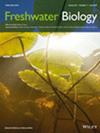Functional and Taxonomic Diversity is Associated With Resource Use Efficiency in Epilithic Algae of Subtropical Qinhuai River, China
IF 2.7
2区 生物学
Q2 ECOLOGY
引用次数: 0
Abstract
- The effects of biodiversity on ecosystem functioning comprise a central ecological theorem (BEF), because more diverse communities are expected to perform better, for example, in terms of resource use efficiency (RUE). Although biodiversity affects ecosystem functioning, it is seriously constrained by global environmental change. Epilithic algae are a crucial benthic functional group in aquatic food webs, but the effect of their biodiversity on ecosystem functioning is yet to be understood.
- Here, we compared the capacity of taxonomic versus functional richness and evenness to predict RUE in a dataset on epilithic algae from the Qinhuai River, Nanjing, China. We examined associations between environmental variables and taxonomic and functional diversity (response and ecological indication), and assessed whether taxonomic and functional diversity measures predicted RUE (quantified as total algal biomass standardised by total phosphorus (RUETP), and total nitrogen (RUETN)).
- Taxonomic and functional diversity varied more across seasons than space, peaking in spring and summer in association with pronounced environmental changes. Water temperature and nutrient concentrations positively and significantly predicted taxonomic and functional diversity measures. Taxonomic and functional richness positively associated with RUE, while functional evenness negatively associated. However, taxonomic evenness was not related to RUE. Structural equation modelling showed that taxonomic and functional diversity were positively associated with RUETP and RUETN. However, taxonomic diversity was more strongly predictive of RUE than functional diversity.
- Our results suggest that RUE is closely linked to species diversity, and functional diversity provides a complementary approach for better understanding of mechanisms underlying the BEF relationship for benthic algae in large rivers.
- We suggest using taxonomic and functional approaches in a complementary way to gain a deeper understanding of the interplay among environmental factors, community diversity and ecosystem functioning.
秦淮河副热带鳞藻功能和分类多样性与资源利用效率的关系
生物多样性对生态系统功能的影响包括一个中心生态定理(BEF),因为在资源利用效率(RUE)方面,更多样化的群落有望表现得更好。生物多样性虽然影响着生态系统的功能,但受到全球环境变化的严重制约。鳞藻是水生食物网中重要的底栖功能类群,但其生物多样性对生态系统功能的影响尚不清楚。在此,我们比较了秦淮河鳞藻的分类丰富度、功能丰富度和均匀度对RUE的预测能力。我们研究了环境变量与分类学和功能多样性(响应和生态指示)之间的关系,并评估了分类学和功能多样性测量是否能预测RUE(以总磷(RUETP)和总氮(RUETN)量化的藻类总生物量)。分类学和功能多样性的季节差异大于空间差异,在春夏季达到高峰,与明显的环境变化有关。水温和营养物浓度正显著预测分类和功能多样性。分类学和功能丰富度与RUE呈正相关,功能均匀度与RUE负相关。然而,分类均匀性与RUE无关。结构方程模型表明,分类多样性和功能多样性与RUETP和RUETN呈正相关。然而,分类多样性比功能多样性更能预测RUE。我们的研究结果表明,RUE与物种多样性密切相关,而功能多样性为更好地理解大河底栖藻类BEF关系的机制提供了一种补充方法。我们建议采用分类学和功能学相辅相成的方法来深入了解环境因子、群落多样性和生态系统功能之间的相互作用。
本文章由计算机程序翻译,如有差异,请以英文原文为准。
求助全文
约1分钟内获得全文
求助全文
来源期刊

Freshwater Biology
生物-海洋与淡水生物学
CiteScore
5.90
自引率
3.70%
发文量
162
审稿时长
2 months
期刊介绍:
Freshwater Biology publishes papers on all aspects of the ecology of inland waters, including rivers and lakes, ground waters, flood plains and other freshwater wetlands. We include studies of micro-organisms, algae, macrophytes, invertebrates, fish and other vertebrates, as well as those concerning whole systems and related physical and chemical aspects of the environment, provided that they have clear biological relevance.
Studies may focus at any level in the ecological hierarchy from physiological ecology and animal behaviour, through population dynamics and evolutionary genetics, to community interactions, biogeography and ecosystem functioning. They may also be at any scale: from microhabitat to landscape, and continental to global. Preference is given to research, whether meta-analytical, experimental, theoretical or descriptive, highlighting causal (ecological) mechanisms from which clearly stated hypotheses are derived. Manuscripts with an experimental or conceptual flavour are particularly welcome, as are those or which integrate laboratory and field work, and studies from less well researched areas of the world. Priority is given to submissions that are likely to interest a wide range of readers.
We encourage submission of papers well grounded in ecological theory that deal with issues related to the conservation and management of inland waters. Papers interpreting fundamental research in a way that makes clear its applied, strategic or socio-economic relevance are also welcome.
Review articles (FRESHWATER BIOLOGY REVIEWS) and discussion papers (OPINION) are also invited: these enable authors to publish high-quality material outside the constraints of standard research papers.
 求助内容:
求助内容: 应助结果提醒方式:
应助结果提醒方式:


